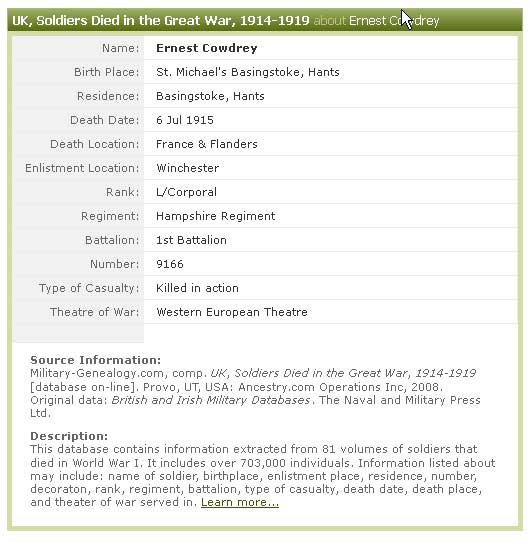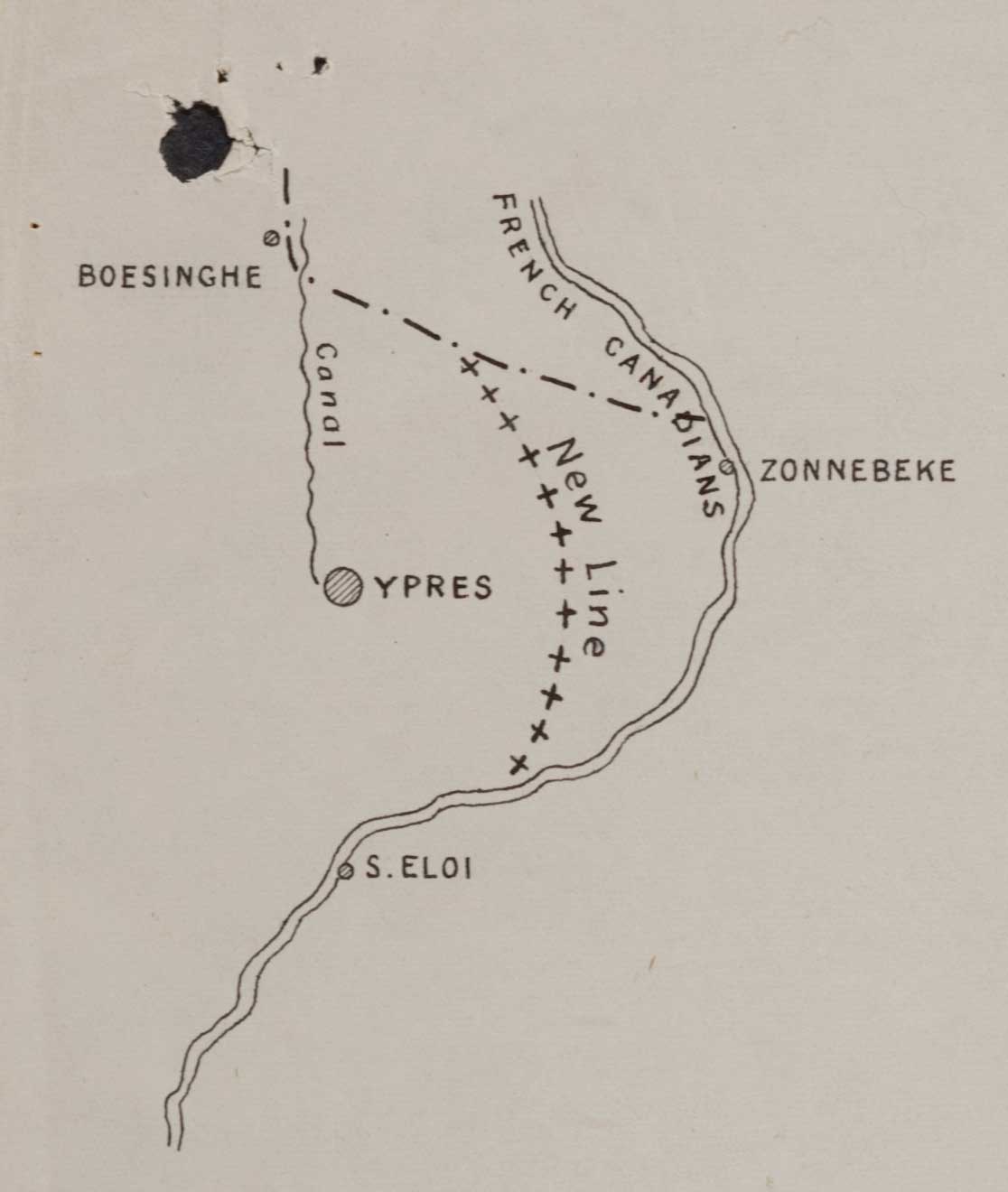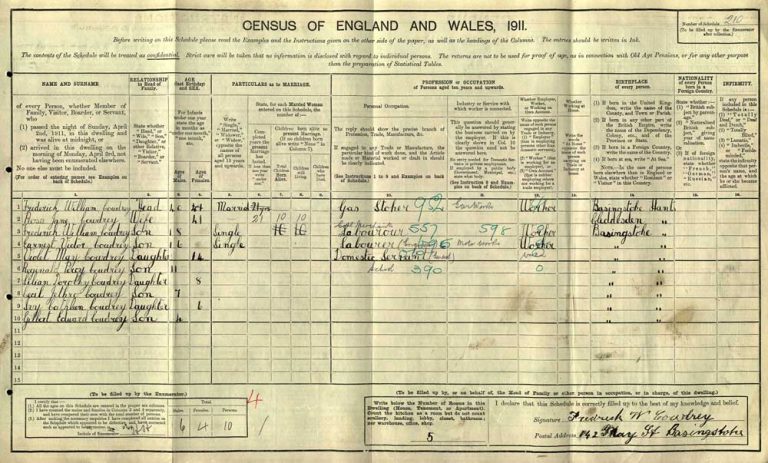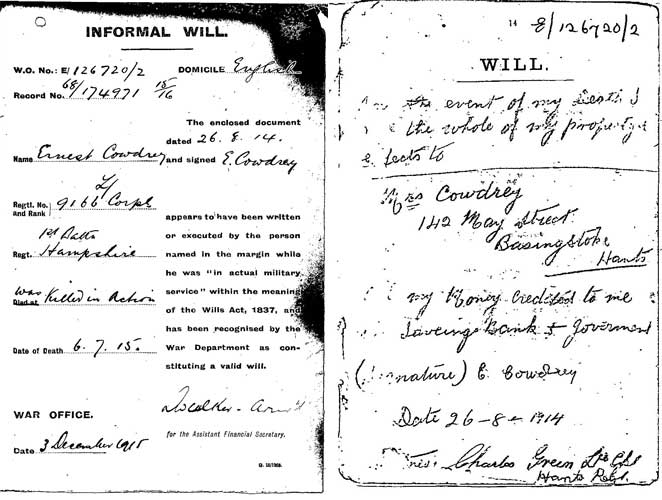In some ways, this blog post has been over 15 years in the making. During my GCSEs I was properly introduced to the First World War while on a battlefield trip to Flanders. I still have my class notes, and the memory of being at the Menin Gate while the Last Post sounded is something I will never forget. I would strongly encourage anyone interested in the First World War to make the trip over to Belgium for this experience. It was also on this trip that I was first ‘introduced’ to Ernest Cowdrey.
My school had, through the Commonwealth War Graves, tracked down my ancestor at Talana Farm cemetery. Although not part of our planned itinerary I remember the coach pulling over and having to run through the fields to a small secluded cemetery. I took some pictures and felt an immense feeling of pride – my ancestor had in some way contributed to the war that I’d been learning so much about. I was also shocked to discover he was only 19 when he died – at the time, only three or four years older than I was myself.
It was the dark days before Google and I wasn’t really aware of what research I could do, so, after sending photos from my trip to relatives, I didn’t find out anymore about Ernest until, a few years later, the BBC ran a documentary about The Forgotten Battlefield. It turns out that Ernest was involved in this lost battle so, of course, I made my university friends watch it! It was amazing to discover that his part in the war, like the others from his battalion, had been somewhat forgotten by history. Although previously overshadowed by Ypres and Gallipoli, the fighting at Boesinghe was finally being uncovered. At the time it felt like I knew everything there was to know – I’d even seen the excavated trenches where Ernest could have been. Whizz forward to 2012 and I volunteered to write a My Tommy’s War blog post and began to realise just how little I knew…
So, for me, the starting point was the picture I’d taken, all those years ago, at Talana Farm cemetery. From his headstone, I had some key pieces of information:
9166 Lance Cpl E Cowdrey
Hampshire Regiment
6th July 1915 Age 19
If you’re planning a battlefields tour, or even if you’re not, you can search the Commonwealth War Graves Commission online to get similar information.
I know where he died and when; his regiment number; and his battalion. Thanks to the BBC documentary I also knew something of what happened – a seemingly large push on 6 July 1915, which at the time Hubert Plumer, Commander of the British troops, declared would ‘go down in history as one of the great battles of the campaign’. Instead it fell into historical oblivion. There were, however, many things I didn’t know – what was Ernest like? when did he sign up? what was his experience of war? and, most poignantly, how did he die?
Armed with the details I had, it was time to hit the collection at The National Archives. Our research guide Looking for the records of the First World War, along with Looking for records of a British army soldier after 1913 has some great advice for you if you’re also at the beginning of your search.
 [/caption]First up, I went to Ancestry. Here I searched the ‘Soldiers died in Great War 1914-19’ and from this entry found some new information. Ernest’s birth place was St Michael’s, Basingstoke and he had enlisted in Winchester. It also confirmed that he was killed in action on the Western European Theatre (France and Flanders).
[/caption]First up, I went to Ancestry. Here I searched the ‘Soldiers died in Great War 1914-19’ and from this entry found some new information. Ernest’s birth place was St Michael’s, Basingstoke and he had enlisted in Winchester. It also confirmed that he was killed in action on the Western European Theatre (France and Flanders).
Whilst on Ancestry I also searched the medal index cards and was surprised to find two cards! They both appear to be for my Tommy, as they have the same regimental number (9166). One card is for the Star medal and the other for the Victory medal. The date of entry for the index card for the Star medal was 23/08/14. I wondered if this was the date that Ernest signed up. I ran a search in the service records, but wasn’t surprised to find that, sadly, his record was part of the 60% destroyed during a Second World War bombing raid. I’m not really sure how else to go about finding out more information on his recruitment. Does the early date suggest that he was in the regulars?
This made me wonder about the man (or boy) who had signed up. I looked up Ernest Cowdrey on the 1911 Census. I found him, living in May Street, Basingstoke with his parents and seven brothers and sisters. He was a labourer/engineer.
I’d previously looked at the war diary for the 1st Battalion Hampshire regiment as part of the Voices of the Armistice podcast series back in 2008. The diary gives an outline of the events on 6 July 1915 – a British counter-attack, following a German gas attack six weeks earlier. After an hour’s artillery barrage the troops went over the top at 06:00. Over 120 soldiers died that day, moving the front line forward a mere 30 yards. A few days later, the battalion’s ‘spendid’ doctor, Captain G. C. Gwynne, was killed, and is named in the war diary. But beyond ranked officers it’s quite unusual for individuals to be named. It can feel quite disappointing that the soldiers aren’t all name-checked, especially when they gave their all. But the war diaries were intended as a record of operations, which is why any instances of personal detail should really be treasured.
Last of all, I searched the new Soldiers Wills. Ernest had indeed made a will, seemingly in the first few days of landing in France. It was amazing to see his handwriting and also reassuring to see that the address matched the address I’d found on the census. Unsurprisingly for someone so young, he left everything to his mum. I can’t image how he would have felt, aged 18, writing a will.
I finally turned to Google to see if I could find out any other information about the battalion’s history. On the Long, Long Trail website I discovered that 23 August (the date on the medal card) was the day the 1st battalion landed in Le Havre. His regiment was part of the 4th division, originally meant to be part of the British Expeditionary Force, but held back at the last minute, to counter any German landing. The Hampshire regiment served throughout the war, were awarded 82 battle honours – the highest number for any regiment during the First World War, and lost 7,580 men.
So what are my next steps? Having discovered (I think) that Ernest was a member of the regular army, I’d like to find out more about the Hampshire regiment – I plan to revisit the war diary, read the regimental history (Royal Hampshire Regiment 1914-1918) and hopefully pay a visit to the regimental archives at Serles House.
I also want to turn my attention to finding out as much as I can about what happened on 6 July 1915. From the BBC documentary I know that there were other regiments involved on that day including the 1st Battalion Rifle Brigade, the Lancashire Fusiliers and the 5 Battalion York and Lancasters. I’ll try ordering their war diaries to see if they can provide any other information about the day that’s not recorded in the Hampshire war diary.
From the CWGC website I can see the soldiers, buried in the same cemetery, who died on the same day. I’d especially like to find out more about those men who were also from the Hampshire regiment. These were:
Edward Ford
R Partland
AT Unwin
W Banfield
A Rousell
And the company Sergeant Major, W T Yates
It feels fitting, with the approaching centenary that we all discover as much as we can about our Tommies and First World War ancestors. By the anniversary of the fighting at Boesinghe I hope to come back and be able to reveal much more of Ernest’s story.





Laura,
you might want to look at the Official History of the First World War (copies are available on TNA’s Library shelves) as they can sometimes give information, the War Diaries themselves were arranged (I believe) at the time the Official Histories were being made. Have you considered that there may be information held in Belgium and also the British Newspaper Archive, especially for his death but perhaps also his recruitment.
Laura,
Paul Nixon’s very useful website, Army Service Numbers 1881-1918, suggests your man joined up sometime in 1912. The page for the Hampshire Regiment is at http://armyservicenumbers.blogspot.co.uk/2012/02/hampshire-regiment-1st-2nd-battalions.html and shows that 9059 joined on 21 February 1912 and 9244 joined on 1 January 1913. He may have joined up legitimately as a boy soldier, or may have lied about his age.
For others researching it’s worth noting that the date recorded on his medal index card is next to the heading “Date of entry therein”, which is below the previous heading “Theatre of war first served in” in other words this shows the date he entered a theatre of war (in this instance the actual theatre hasn’t been indicated, but is obviously France and Flanders).
The absence of the notation “Clasp and roses” shows that his next of kin didn’t apply for the clasp to the 1914 Star which was issued to those who actually served under fire between August and November, though presumably he would have been entitled to it.
David
My treck started when my mother asked my to see if I could find our something about her uncle who was killed in the Great War. Little did I know that this would occupy my time until I had tracked down every man who had enlisted in his original unit, the 94th “New Ontario” Battalion, Canadian Expeditionary Force. It was broken up when it reached Great Britain and her uncle was placed in the 46th “South Saskatchewan” Battalion were he served with distinction, rising to the Rank of Sergeant. He was killed on the first day of the last battle of Paeschendael, where the Canadians were sent in to save “Bloody Haig’s ” reputation and position with the BEF. If you are interested, my website is at http://www.94thbattalioncef.ca
This is an amazing website. Thank you for sharing.
I am not British, but American. However, I did live in London in 2005 (and was on one of the buses hit by terrorists on 7 July – I was on my way to Heathrow and got off just before the bombings occurred). The centenary of the First World War affects me as well. My great-grandfather’s brother, Louis Davidson (1879-1947), served as an ambulance driver in France during the war. Louis, the son of Orthodox Jews from Russia who came to America and settled in New Bedford, Massachusetts, joined the US military in 1916 in time to serve under Gen. “Black Jack” Pershing in hunting for Pancho Villa in Mexico. He later served in France from 1917 until the end of the war in November 1918. I was able to get his records located in our National Archives for military records in St. Louis, Missouri. Louis’ son, Clifton Louis Davidson (1923-1944) was later a waist gunner on a B-24 Liberator, “The Maiden USA,” which was shot down by German fighter planes over the town of Cesena, Italy, on 25 April 1944. Louis’ other son, Irving “Dave” Davidson, also served during the Second World War, in the US Army Air Corps (USAAC) and then the Office of Strategic Services (OSS), the forerunner of the modern CIA, as a saboteur in France prior and after the D-Day landings in 1944. I have other family members who served in the Second World War, the Korean War, and even the Vietnam War, but your blog post interested me enough to mention my family on my Davidson side. Cheers to all of you.
A really brilliant read Laura.
I had a quick scout about over the weekend, and there are brief biographies of the men you were interested in here: http://jessamycarlson.wordpress.com
Great read, Laura! Hope you will use Hampshire Archives and Local Studies to forward your research. Maybe you could pay us a visit when you go to Serles House.
For info, we hold the regimental archives of The Rifle Brigade and King’s Royal Rifle Corps.
We also hold a huge amount of sources about Hampshire in the Great War.
Great read, Laura!
My Grand father also served with the Ist Hampshire’s, he also went over with the BEF on 22/23 August 1914 . Have you visited the WW1 Remembrance Centre @ Fort Widley
Portsdown Hill Rd Portsmouth, I’m a volunteer guide there we have some very knowledgeable staff they my be able to help your research
Opening Hours daily 10:30am-6:00pm till Christmas
after Christmas 11:00am-16:30pm, visit Facebook WW1 Remembrance Centre
Laura
My great grandfather was with the 1st East Lancashire Regiment. He was killed on July 6, 1915, and is buried in Talana Farm Cemetery. I have quite a bit of information about the day that I’d be happy to share with you.
Thanks for an excellent post.
Gary
For Gary Blakeley
I am helping a team who are tracking down those on their village war memorial. One name is Private Frank Reginald Hillier died 06/07/15: 1st East Lancs: Talana Farm Cemetery Ypres grave II. E. 34. We would be grateful for the information you mention about that day, to put with acknowledgement on a website page about Frank Hillier.
Thank you.
I’d Love to find out if this chap was my relation or not. i am originally from Hampshire now living in New Zealand.
William Banfield HTS 6946 (HTS = Hants, Hampshire Reg.) was my grandfather’s brother. I would very much like to go over in July 2015.
Thank you for the information on here.
Thank you so much for directing me to Soldiers Wills….I found my man, KRRC he was my Great Uncle, will I be able to access the Will on Gov.uk as he is not directly related to me.
Thanks for the research pointers – I wasn’t aware of the regimental numbers and soldier’s wills sites. My Great Uncle Rupert Head (Service Number 7774) was a regular soldier in the 1st Battalion at the outbreak of the war and died at Langemark on October 4th 1917. I had no idea that he was a regular soldier or that the Hampshires took part in so many key battles – Marne, Somme, Ypres, Paschendale. He was lucky to have made it to 1917 given the experience of the Somme in particular. If I was superstitious I’d say it was his service number – three lucky sevens for 1914, 15, & 16 – but sadly a 4 for 1917…
My grandfarther was in the Hampshire reg he was wounded at the somme in 1916 but whent back to fight in the war with his brother shepherd baker that was on my mothers side but my dads oldest brother Charlie smith was in the same reg I cant seem to get any were my grandfarthers name is Henry Baker we are romany family they lived on chobam common at that time if any one can help me please get in touch I would be greatful
Hi Michael,
Unfortunately we’re unable to help with family history requests on the blog, but if you go to our contact us page: http://nationalarchives.gov.uk/contact/ you’ll see how to get in touch with our record experts via phone, email or live chat.
I hope that helps.
Nell
I am obsessed with Talana Farm Cemetery, which is in my village. (And so is my British/Canadian friend Gary, who wrote a posting here a while ago.) I know Ernest Cowdrey’s grave (of course).
This posting just to say that I was a little surprised that there is no portrait of Ernest Cowdrey here. As I have one (in digital form). And a memory card. It must have been sent by a descendant. But … after a PC crash 10 years ago, I cannot find who that was …
Aurel Sercu
Boezinge – Ieper (Ypres)
I’ve researched the men on the Petersfield war memorial. Many of them were in the Hampshires. Here’s what I found for Richard Partland.
Born in Boyle, Roscommon, Ireland in 1887
An ex-regular soldier with previous service in South Africa, Richard Partland was a reservist emplyed at Lukers Brewery and resident in Petersfield when war broke out.
Private Partland would have been recalled to the Battalion in Winchester and gone to France on 21st August. As a result he would have been involved in the retreat from Mons and the Battle of Le Cateau. In July 1915 the Battalion were in the Ypres area and on the 6th they attacked and captured an enemy trench, with only 9 killed and 27 wounded. One of those was Richard Partland.
Died 6th July 1915 aged 28 years.
Buried at Talana Farm Cemetery, Ieper, Belgium. Plot 11, Row D, Grave 18